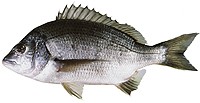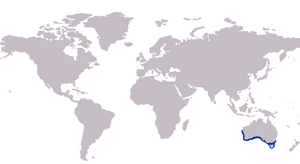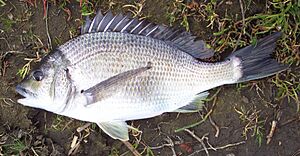Black bream facts for kids
Quick facts for kids Black bream |
|
|---|---|
 |
|
| Scientific classification | |
| Genus: |
Acanthopagrus
|
| Species: |
butcheri
|
 |
|
| Distribution of Acanthopagrus butcheri | |
| Synonyms | |
|
Mylio australis Günther, 1859 |
|
The Acanthopagrus butcheri, often called the black bream or southern black bream, is a type of fish. It belongs to the porgy family, called Sparidae. This fish lives in both salty ocean water and fresh river water. It has a deep body and can sometimes be confused with other similar fish. You can usually tell it apart because it doesn't have yellow fins on its belly or near its tail. Southern black bream are only found in Australia. They live along the southern coast, from Shark Bay in Western Australia all the way to Mallacoota, Victoria, and also around Tasmania.
This fish mostly lives in estuaries (where rivers meet the sea) and coastal lakes. It rarely goes into the ocean because it needs estuaries to complete its life cycle. When it's time to breed, the fish swim up into rivers to lay their eggs. A few months later, many young fish appear in the estuaries. Southern black bream are "opportunistic predators," which means they eat many different things. Their diet includes crabs and prawns, molluscs (like mussels), worms, and even other small fish.
The southern black bream is very popular with both commercial fishermen and people who fish for fun. This is because its meat tastes good. Commercial fisheries catch over 300 tonnes of these fish every year. Anglers (people who fish for sport) also like catching them because they put up a good fight. New ways of fishing with lures have made them even more popular. Scientists are also trying to farm these fish, but they grow slowly, which is a challenge for large-scale food production.
Contents
Understanding the Southern Black Bream
How the Fish Got Its Name
The southern black bream is one of 20 types of fish in the Acanthopagrus group. This group is part of the porgy family called Sparidae. At first, people thought the southern black bream was the same as a very similar fish found on Australia's east coast, called the surf bream (Acanthopagrus australis).
In 1949, a scientist named Ian Munro studied Australian "silver breams." He discovered that M. australis was actually two different species. He then gave the southern black bream its own new name: Mylio butcheri. Later, scientists realized the fish belonged to the Acanthopagrus group, so its name was changed to Acanthopagrus butcheri.
The Acanthopagrus butcheri has several common names. Many of these names are also used for other fish. To avoid confusion, it's often called the "southern black bream" in scientific papers. Regionally, it's known as "black bream," "Perth bream," "Gippsland bream," and "blue-nose bream." The name "blue-nose bream" is used for older fish that weigh over 1 kg, because their snouts start to look bluish.
What the Southern Black Bream Looks Like
The southern black bream has a deep body that is somewhat flat from side to side. Both its back and belly are equally curved. Its mouth is a medium size compared to its body. It has six curved, peg-like teeth at the front of both its upper and lower jaws. At the sides of its jaws, it has molar-like teeth for crushing food.
Its body is covered with large scales. Most of its head doesn't have scales, except for parts of its gill cover. A low, scaly layer covers the bases of its soft fins. It has a line of scales along its side, called the lateral line, with 52 to 58 scales.
The fish has one dorsal fin (on its back) with 10 to 13 stiff spines and 10 to 13 soft rays. Its anal fin (on its belly, near the tail) has 3 spines and 8 to 10 soft rays. The pectoral fins (on its sides, like arms) have 14 to 16 rays, and the ventral fins (on its belly, like legs) have one large spine and 5 soft rays.
The southern black bream is golden brown or bronze on its back and sides. It can look greenish when it's fresh out of the water. Its belly and chin are white. All its fins are dark, and its tail fin is often a dark olive-brown. This fish can grow up to 60 cm (about 2 feet) long and weigh up to 4 kg (about 9 pounds). However, it's more common to find them around 23-25 cm (9-10 inches) long and weighing less than 2 kg (4.4 pounds).
Where Southern Black Bream Live
Habitat and Distribution
The southern black bream is found only in southern Australia. It lives in coastal waters from Shark Bay in Western Australia to Mallacoota, Victoria, and all around the coast of Tasmania. This fish mostly stays close to shore, but sometimes it's found on deeper reefs on the continental shelf.
Southern black bream mainly live in estuaries. During the summer breeding season, they swim far up into freshwater creeks and rivers. They also live in many coastal lakes and estuaries that sometimes open to the sea. In estuaries and freshwater, they like to hide near things like fallen tree branches, jetties, oyster leases, and rocky areas. In deeper parts of coastal lakes, they are often found over bare mud and sand. They rarely live in the ocean, but if they get washed out of creeks during floods, they can survive in the sea. There, they live on reefs and rocky shorelines near the coast.
This fish is most common in southern Victoria, where it lives in many estuaries. The Gippsland Lakes, Mallacoota Inlet, and Lake Tyers have the most fish. In South Australia, there aren't as many, with the Coorong and Kangaroo Island being the main areas where they are found. This might be because South Australia has fewer rivers and estuaries. In southern Western Australia, southern black bream are very common, with large numbers in estuaries like the Culham and Stokes Inlets.
Southern Black Bream Biology
Diet and Feeding Habits
Southern black bream are "omnivores," meaning they eat both plants and animals. They eat a wide variety of prey, including creatures that stay in one place, burrow in the mud, live on the bottom (benthic), or swim in open water (pelagic). What they eat can change depending on the river, but they are always looking for food.
They often eat crabs, prawns, and tiny shrimp-like creatures. They also eat many types of worms. They can crush bivalves like mussels and cockles with their strong jaws. Small fish like gobies and anchovies are also part of their diet. A type of Algae called Enteromorpha is also a big part of what they eat. Fish living higher up in rivers eat different things, like insects, small fish called hardyheads, tadpoles, and snails.
Studies show that young fish eat smaller things like tiny shrimp and worms. As they get older, they start eating bigger things like large mussels, crabs, and other fish. Southern black bream actively search for food on the bottom, swimming with their heads down and quickly snapping up their prey.
Life Cycle and Reproduction
Southern black bream become old enough to reproduce at different ages. Fish in Western and South Australia are ready to breed by two to three years old, while those in Victoria mature at five years. Females usually mature one year later than males.
The time they lay eggs also changes depending on where they live. In Western Australia, they can spawn from July to November. In South Australia, it's between November and January, and in Victoria, it's October to November. When it's time to reproduce, the fish swim up into the upper parts of rivers and streams to lay their eggs. Each female can produce up to three million tiny eggs per season. The eggs float in the water and hatch about two days after being fertilized.
Young bream spend their first four years living in rivers, estuaries, and parts of the coastline. They often swim in groups over seagrass beds in shallow parts of estuaries. When they turn five years old, fish that live in the ocean move to deeper reefs. They still return to the rivers to spawn, because they cannot complete their life cycle entirely in the ocean. Southern black bream can live for up to 29 years.
Sometimes, a southern black bream can have both male and female reproductive parts. Also, these fish have been known to hybridise (mix genes) with the yellowfin bream (Acanthopagrus australis). This creates young fish that can also reproduce. This usually only happens in special cases, like when the two species are stuck together in a coastal lake for a long time.
Predators and Parasites
Besides humans, many seabirds hunt southern black bream. Pelicans, little black cormorants, and great cormorants are common predators. Larger fish also eat them, including sharks, rays, and big predatory fish like mulloway and flathead.
Southern black bream can also have tiny creatures living on them, called ectoparasites. These include small crustaceans like copepods and isopods, as well as leeches and different types of worms.
Southern Black Bream and People
Southern black bream are very important for both commercial and recreational fisheries. People value them because their meat is tasty and moist. Because they are popular and can live in different levels of saltiness, scientists are looking into farming them in salty ponds inland.
Commercial Fishing
The southern black bream is one of the most important fish for commercial fishing in Victoria and southern Western Australia. However, fewer are caught in South Australia because there aren't as many fish there. Victoria catches the most, with the Gippsland region alone providing 80% of the state's total.
People have been catching A. butcheri from the Gippsland Lakes since the 1880s. The amount of bream caught from these lakes now changes between 200 and 400 tonnes each year. The Mallacoota Inlet and Lake Tyers are also important areas for catching bream in Victoria. In South Australia, bream are only caught commercially from the Coorong.
In Western Australia, the Culham and Stokes Inlets provide most of the state's catch. The fish are usually caught using gill nets, beach seine nets, and by handline. The fish are typically sold fresh, either whole or as fillets, in local markets.
Fishing for Fun

Southern black bream have always been a favorite for anglers. People like to catch them because they fight hard and their meat is delicious. Bream are also popular because they are easy to reach. You can often catch them from harbour and estuary banks, piers, and rock walls, so you don't always need a boat. Studies in Western Australia have shown that people fishing for fun catch more bream than commercial fishermen.
Bream are often found around structures in an estuary, like fallen branches, piers, rock walls, and bridges. They also like mud and sand banks where shellfish and crabs live. Even though bream eat many things, they can be hard to catch in places where a lot of people fish. Anglers use light fishing lines and sinkers so they don't scare the fish. Using live bait like small crabs, prawns, and worms usually gives the best results. Frozen or cut bait like prawns, mussels, and fish pieces also work well.
Fishermen often throw chopped pilchards or chicken pellets soaked in fish oil into the water to attract fish. In recent years, people have started using lures and flies to catch southern black bream. The fish are known to bite on hard plastic lures, spinnerbaits, soft plastic lures, and saltwater flies.
The southern black bream is protected by rules about how big they must be and how many you can catch in all the states where they live. Anglers must know these rules to avoid fines. For example, in Western Australia, the fish must be at least 25 cm long.
Fish Farming (Aquaculture)
Southern black bream are fairly easy to grow in captivity. They usually lay eggs during their natural breeding season without needing extra help. However, they are not raised for food on a large scale because they grow slowly and don't produce a lot of meat (fillet).
Despite this, studies have shown that these fish can live well in salty ponds if the water is deep enough and they are given food. This has led to ideas about breeding them to stock inland salty ponds for recreational fishing, similar to how trout and barramundi are stocked in other parts of Australia. Even though they grow slowly for food production now, scientists hope that by choosing specific fish to breed, they can create faster-growing ones for the market. Southern black bream are already being bred to restock estuaries where their numbers are low, so we know a lot about how to farm them.
Similar Fish Species
Several other fish in the Sparidae family live in Australian waters and might be confused with A. butcheri. The yellowfin bream, Acanthopagrus australis, looks very similar to A. butcheri. You can tell the yellowfin bream apart by its yellow fins.
Another similar fish in the west is Acanthopagrus morrisoni, the western yellowfin bream. This one also has prominent yellow fins on its belly, near its tail, and on the lower part of its tail fin. The tarwhine, Rhabdosargus sarba, also has a similar shape, but it has gold horizontal stripes that help you identify it.

